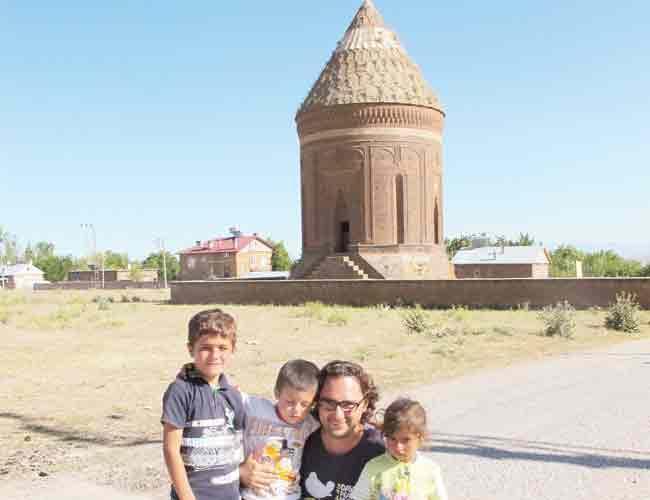Ahlat, an open-air museum
Melih Uslu

I‘m in Ahlat, currently a candidate for UNESCO World Cultural Heritage status. Ahlat (or Akhlat) is the gateway to Anatolia. Here, on Lake Van’s most scenic shores, are the city of Bitlis, the city of our Ottoman forefathers, and the Islamic dome of the Seljuks.
Ahlat, a city perched like a seaside town on a gentle slope covered in fruit orchards. Surveying the deep blue waters of Lake Van and the snowy peaks of Süphan, Turkey’s third highest peak, as you sip your tea here is a pleasure like no other. Its natural beauty and fertile plain have made Ahlat a popular area of settlement throughout
history.
From the Urartu to the Ottomans, these lands have been home to numerous civilizations during their glorious 1,500-year past. The town also enjoys the distinction of being the largest founded by the Turks in Anatolia following the Battle of Manzikert in 1071. Turkish tribes began pouring into the region after the clash, in which the Turks routed the Byzantines.
On the stone monuments at Ahlat, dubbed “City of the Oghuz Tribe” by Ottoman explorer Evliya Çelebi, you will find traces of the Turkish clans that settled in the region following the great battle. The Oghuz Kayı Clan, which founded the Ottoman Empire, stayed in Ahlat for 170 years prior to settling in Söğüt in the second half of the 13th century. Legend has it that Ertuğrul Gazi, the father of Osman Bey who founded the Ottoman dynasty, was born in Ahlat and lived there into his 20s.
The Sea of Ahlat
We know that the fish caught in Lake Van, formerly known as the Sea of Ahlat, are one of the city’s major sources of income.
The local people, who made masterful use of the lake for shipping in the Middle Ages, quickly transformed Ahlat into a commercial hub. With a population of around 300,000 in the 13th and 14th centuries, Ahlat was the political capital of a vast swath of land stretching from Diyarbakır to Tabriz, becoming a city of culture and learning as well with economic prosperity.
Among the famous figures produced by the city, which trained scholars in diverse fields from medicine to astronomy, are the celebrated philosopher Abu Ali al-Ahlati, the chemist and inventor Ibrahim ibn Abdullah of Ahlat, the astronomer Fahreddin Ahlati and the religious scholar Sheikh Husaini Ahlati.
But Ahlat was also a city of artisans and architects. The domed Seljuk mausoleums (kümbet or gonbad) and the shapes of the columns of the Orkhon Monuments, the oldest inscriptions in the Turkish language, were brought to Anatolia from Central Asia, producing their finest examples at Ahlat.
Although the sources mention some 100 plus Seljuk mausoleums at Ahlat, only around 15 are still standing today and two of those are semi-destroyed. But even this figure exceeds the total number in other parts of Turkey. The most outstanding of the Ahlat kümbets, which throw light on three centuries of artistic development from the 13th to the 15th century, bear the names of Sheikh Najmuddin, Erzen Hatun, Usta Shagird and Bayındır.
City of ruins
Situated in a long, narrow valley, the center of Old Ahlat is known as a “city of ruins.” With remnants of Seljuk castles, mosques, bridges, towers, baths and dervish lodges, this place is like a giant open-air museum. And cheek by jowl with this mysterious city rife with the remains of structures carved into the rocks is the world’s largest Turkish-Islamic graveyard. I tour this vast site, unmatched in the world in terms of architectural richness, with Ahmet Çapkun, a researcher based at the Ahlat Museum.
Çapkun says that upwards of 8,100 mausoleums of historic significance have been identified in the Seljuk Graveyard, which covers approximately 50 acres. There are monumental stones as high as 3.5 meters at this burial site, which was used continuously between the 11th and 16th centuries. The main material
used in the mausoleums, which include sarcophagi and cists either with or without inscriptions, is the volcanic red stone peculiar to the area.
Professor Altan Çetin says that the stone decorations here represent some of the rarest examples of ornamentation from the Seljuk period. He adds that geometric motifs, vegetal patterns and stylized scripts were virtually worked like lace into the stone used in the mihrabs, rosettes, muqarnas work and star motifs seen in Seljuk architecture. A kind of volcanic tufa, Ahlat stone continues to be worked today.
Local stonemason Tahsin Kalender was added to the UNESCO Living Human Treasures List in 2012. And indeed the stone here seems to whisper of the countless travelers who have passed through these lands. If you listen closely, you will hear a lot more than I have told you here in Ahlat, a once-vibrant Anatolian settlement that rose to a pinnacle in art, science and religion.
While you’re in Ahlat, you can visit the Bitlis Ethnographic Museum where you’ll find manuscript works as well as a host of local artifacts and reanimations. Another recommended sight at Bitlis is the medieval inn called Yeni (New) Papşin Han. Converted into a handicrafts school today, this historic hostel also offers occasional evening concerts. On the other hand, what can you buy there? Firstly Ahlat’s famous tradition of handmade canes traces its roots back to Central Asia to Anatolia.
What distinguishes these canes is their array of Turkish motifs carved in walnut wood. The price of the canes, decorated with animal figures, ranges as high as 3,400 Turkish Liras (around 500 euros). And the second the best-known dish in Ahlat, which boasts a rich array of original dishes, is Bitlis-style büryan kebab. Other tastes unique to the region include a meatball soup known as “klorik,” a pickled cabbage dish called “çorti taplama,” a dish made of pounded meat wheat named “harise” (kind of keşkek), pickled “kenger” (thistle), salted pearl mullet, and “murtuğa” helvah with egg. Have a nice trip and enjoy your meal.
The most convenient way of getting to Ahlat is to fly to the eastern province of Muş, just an hour and a half by car.
Domestic airlines have Istanbul - Muş - Istanbul flights every day of the week.
















